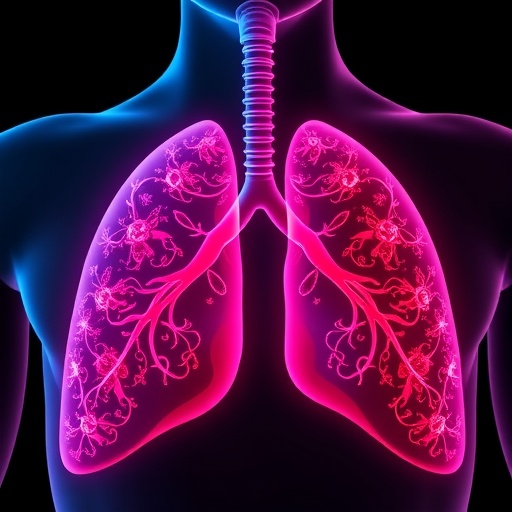Pulmonary fibrosis stands as one of the deadliest respiratory diseases, characterized by progressive thickening and scarring of the lung tissue that ultimately impairs oxygen exchange vital to human survival. Despite its severity, therapeutic avenues remain limited, leaving patients with a prognosis comparable to that of advanced lung cancer—a grim median survival of approximately five years post-diagnosis. In a groundbreaking study spearheaded by researchers at the University of California, San Francisco, a pivotal molecular pathway underlying pulmonary fibrosis has been elucidated, opening promising doors for intervention that could redefine patient outcomes.
Central to the new discovery is a cellular protein known as IRE1α, a key sensor and regulator of the unfolded protein response—a stress signaling pathway activated in the endoplasmic reticulum when misfolded proteins accumulate. Under normal circumstances, IRE1α assists in restoring cellular homeostasis; however, the UCSF team unveiled its darker role in pulmonary fibrosis. Specifically, IRE1α exacerbates disease by engaging a process termed regulated IRE1-dependent decay (RIDD), wherein it selectively degrades messenger RNA transcripts coding for proteins vital to maintaining healthy lung cell identity.
Among the critical targets of RIDD is FGFR2, a receptor tyrosine kinase essential for alveolar type 2 (AT2) cells to preserve their functional and phenotypic characteristics. AT2 cells, known for their regenerative capacity, normally repair alveolar damage by differentiating into other cell types necessary for lung maintenance. However, the targeted degradation of FGFR2 mRNA impairs AT2 cell identity and traps these cells in a dysfunctional transitional state. This aberrant cell state not only loses reparative function but actively contributes to fibrotic remodeling by secreting pro-fibrotic signals, thus perpetuating tissue damage and scarring.
To interrogate the therapeutic potential of modulating IRE1α activity, the researchers employed an innovative pharmacological approach using a selective kinase inhibitor called PAIR2. This molecule was meticulously engineered to dampen the damaging RIDD function of IRE1α while sparing its beneficial roles in normal cellular stress management. This nuanced “Goldilocks Zone” inhibition ensures critical cell survival pathways remain intact, preventing untoward systemic effects that might arise from wholesale blockade of IRE1α in all tissues.
In murine models mimicking human pulmonary fibrosis, administration of PAIR2 yielded striking results. Treatment not only halted the progression of existing fibrotic lesions but also partially reversed established scarring. At the cellular level, PAIR2 preserved AT2 cell identity by preventing the loss of FGFR2 expression, thus reducing the burden of harmful transitional cells and markedly attenuating the pathological accumulation of extracellular matrix proteins characteristic of fibrosis.
These findings herald a paradigm shift in our understanding of pulmonary fibrosis pathogenesis and treatment by validating a novel molecular target whose action intricately links cellular stress responses to tissue remodeling. The study underscores the pathological consequences of maladaptive stress signaling pathways and positions IRE1α’s RIDD activity as a therapeutic choke point, with broad implications not only for pulmonary fibrosis but potentially for other conditions marked by dysfunctional cell identity changes, such as diabetes, neurodegenerative diseases, and chronic liver disease.
Notably, Dr. Feroz Papa, one of the study’s co-senior authors and a professor at UCSF, emphasized the transformative potential of this discovery in expanding the currently dismal landscape of pulmonary fibrosis therapies. The selective inhibition strategy champions the virtue of precision medicine, targeting pathological mechanisms without disrupting vital cellular processes, a balance that has eluded many drug development efforts to date.
Complementing this perspective, Dr. Dean Sheppard, also a co-senior author and former Chief of the Division of Pulmonary, Critical Care, Allergy, and Sleep Medicine at UCSF, highlighted that the study exemplifies the critical role of fundamental biomedical research. Years of meticulous inquiry into lung cell biology and molecular mechanisms culminated in the translational leap toward actionable therapeutics, exemplifying a bench-to-bedside trajectory.
While PAIR2’s preclinical performance offers a ray of hope, the path toward clinical application remains complex. Subsequent investigations are imperative to rigorously evaluate the drug’s safety profile, pharmacokinetics, and delivery mechanisms in humans. Moreover, given the diverse etiologies and clinical presentations of pulmonary fibrosis, comprehensive trials will be necessary to assess the generalizability of these findings across patient subpopulations.
Beyond pulmonary fibrosis, the implications of modulating IRE1α’s RIDD activity extend into a wider biomedical context. The mechanistic insight that aberrant control of gene expression via selective mRNA decay can decisively influence cell fate decisions paves the way for novel intervention strategies across diseases characterized by maladaptive cellular stress responses, ranging from metabolic syndromes like diabetes to debilitating neurodegenerative processes.
The research further exemplifies the growing appreciation for how protein quality control mechanisms within the cell—once considered mere housekeeping functions—play integral roles in disease pathology when dysregulated. Targeting these pathways requires sophisticated molecular tools, as demonstrated by PAIR2, which fine-tunes protein activity to retain beneficial functions while mitigating pathological effects.
In summary, the unveiling of IRE1α’s role in driving maladaptive cellular transformations within the lung provides a crucial molecular foothold in the fight against pulmonary fibrosis. The innovative selective inhibition approach represented by PAIR2 heralds a new era of targeted therapies aimed at preserving lung architecture and function. As this research progresses from animal models toward human clinical trials, it underscores the power of fundamental scientific discovery to unravel complex diseases and inspire hope for patients facing life-threatening conditions lacking effective treatments.
Subject of Research: Pulmonary fibrosis, cellular stress responses, alveolar type 2 (AT2) cells, IRE1α protein, regulated IRE1-dependent decay (RIDD), targeted molecular therapy
Article Title: New Molecular Approach Halts and Reverses Lung Scarring in Pulmonary Fibrosis Through Selective Inhibition of IRE1α
News Publication Date: October 15, 2025
Web References:
– Journal of Clinical Investigation https://www.jci.org/articles/view/184522
– UCSF Health https://www.ucsfhealth.org/
– UCSF Homepage https://www.ucsf.edu/
Keywords: Pulmonary fibrosis, lung scarring, IRE1α, RIDD, alveolar type 2 cells, FGFR2, molecular targets, stress response, selective kinase inhibition, basic research, fibrosis reversal, pulmonary alveoli, lung repair mechanisms




